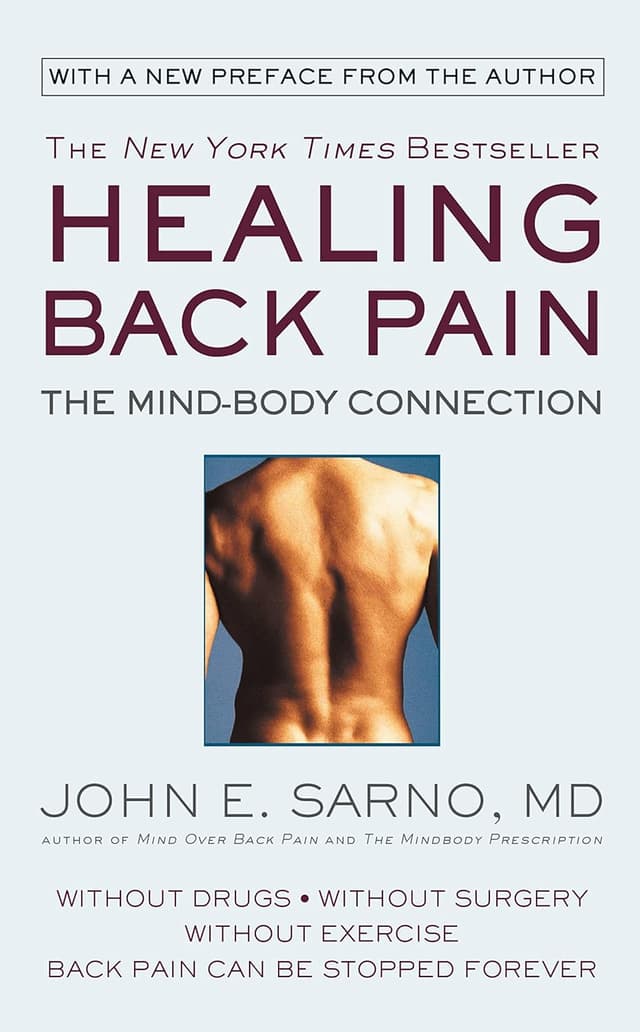Noah Brier | June 1, 2022
The Back Pain Edition
On root causes, the mind, and resolution
Recommended Products

A 1991 book by John Sarno that argues a lot of back and neck pain originates from the mind, not the spine or other joints.
Noah here. At various times in my life, I’ve suffered from neck and back pain. That hardly makes me unique, though: Georgetown Health Policy Institute says 65 million Americans have recently dealt with an episode of back pain. Usually, when some pain hit I’d just take it easy and wait things out: rest my back, get a massage, take some ibuprofen, whatever. Eventually, it would fade away and I could get back to my life. A few years ago, however, I had a bout of lower back bad enough to push me to see a physical therapist. After about eight weeks of no progress, my pain switched sides (which seemed insane) and I remembered back to a recommendation a friend had made about a book that argued a lot of back pain was psychosomatic.
Healing Back Pain by John Sarno is a 1991 book that argues that a lot of back and neck pain originates from the mind, not the spine or other joints. Sarno, who practiced internal medicine at NYU Hospital, delved into a bunch of different reasons the pain manifests (some of which don’t resonate with me), but the basic argument is that for many of us pain is a physical manifestation of stress. Friend of WITI Juno DeMelo wrote about Sarno and Healing Back Pain for the New York Times back in November. The piece starts with an amusing warning (“I swear I’m not woo-woo, but…”) and goes on, to sum up the latest around Sarno’s mind-body theory. The gist is that while Sarno almost definitely had some of the details wrong (his specific idea around reduced blood flow to affected muscles, for instance, is considered unlikely), there’s more acceptance today of the brain’s role in pain. This particular point from DeMelo resonates with the current opioid crisis, for instance:
Pain can beget more pain. For example, an injury may turn up the volume on your pain response to future injuries. Stress may cause pain to persist long after an injury has healed. And if your back twinges and you start imagining all the ways it could get worse, that fear can magnify your pain, which may lead you to avoid physical activity, which then makes the pain even worse. Experts call this the pain cycle.
Why is this interesting?
I was thinking of Healing Back Pain recently after listening to an episode of Julia Galef’s always excellent podcast Rationally Speaking with economist and Nobel laureate Angus Deaton. Deaton and his Princeton collaborator Anne Case coined the term deaths of despair to describe the rise in drug overdoses, alcoholic liver disease, and suicides. All three causes of death are, in one way or another, self-inflicted and, to their view, a result of feelings of abandonment and disconnection. About a third of the way through the podcast, the conversation turns to the rise in chronic pain and its role in deaths of despair. The question Galef asks effectively boils down to whether Deaton believes pain is the root cause or just part of the causal chain. Deaton argues it’s most likely the latter. More importantly, he asks where the pain comes from in the first place:
Working in McDonald's is not going to give you more pain than working on an assembly line. (Though working in an Amazon warehouse might well.) But we think of it—and that's why we quote the neuroscience literature where lots of people are thinking of it—is that being excluded can be a source of, you know, things like lower back pain, but it's all very mysterious. No one really knows what's driving that. Some people think the drugs are driving.
Like the pain itself, we can’t be sure of the exact mechanism. But it seems like being open to the idea that emotions can manifest themselves physically—and that the resulting pain isn’t any less real than any other—is a useful step for people individually and collectively. (NRB)
—
WITI x McKinsey:
An ongoing partnership where we highlight interesting McKinsey research, writing, and data.
Marketing in the metaverse. Although widespread adoption of the metaverse may take some time, leading brands are already rewriting the rules of marketing. Here’s how marketers and companies can start experimenting and exploring what the metaverse can offer.
—
Thanks for reading,
Noah (NRB) & Colin (CJN)
—
Why is this interesting? is a daily email from Noah Brier & Colin Nagy (and friends!) about interesting things. If you’ve enjoyed this edition, please consider forwarding it to a friend. If you’re reading it for the first time, consider subscribing (it’s free!).

